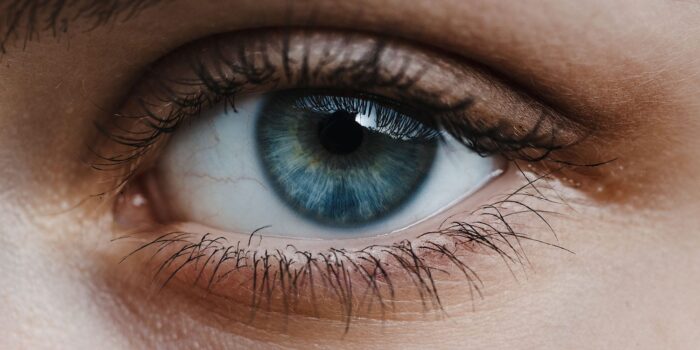Researchers on the College of Rochester have made groundbreaking developments in our understanding of colour notion. In a latest examine revealed within the Journal of Neuroscience, they recognized uncommon retinal ganglion cells (RGCs) that would fill important gaps in our information of how we see colours. These findings point out that, along with the established colour detection pathways adopted by most RGCs, a small variety of these non-conventional cells might play an essential position in colour imaginative and prescient.
The examine was pushed by a basic query in visible neuroscience: how does the human eye course of and understand colour? Scientists have lengthy recognized that the retina comprises three forms of cone photoreceptors delicate to brief, medium, and lengthy wavelengths of sunshine. These cones transmit data to the mind through retinal ganglion cells.
Within the Eighties, analysis by David Williams on the College of Rochester recognized three major pathways — referred to as cardinal instructions — that describe primary colour detection. These cones transmit data to the mind by way of RGCs, following three cardinal instructions: luminance (combining alerts from medium and lengthy wavelengths), red-green (opposition between lengthy and medium wavelengths), and blue-yellow (opposition between brief wavelengths and the mixed alerts of medium and lengthy wavelengths).
Nonetheless, these pathways don’t totally clarify how people understand the richness and variety of colours. The researchers suspected that alongside these major pathways, there may be further, much less frequent RGCs that play an important position in colour notion.
To discover this speculation, the researchers employed superior imaging methods. They used adaptive optics, a know-how initially developed by astronomers to right for distortions in telescopic photographs brought on by the Earth’s environment. This know-how was tailored to right for distortions within the eye, offering unprecedented readability of particular person photoreceptor cells.
The examine concerned imaging the eyes of three macaque monkeys utilizing adaptive optics and calcium imaging. These methods allowed the scientists to watch and measure the responses of RGCs within the fovea, the central a part of the retina answerable for sharp central imaginative and prescient. The macaques have been chosen for his or her similarities to human imaginative and prescient.
The researchers administered viral vectors to the monkeys to specific a calcium indicator within the RGCs. This indicator allowed the cells to fluoresce when activated by gentle, enabling the scientists to trace their responses to numerous colour stimuli. The monkeys have been proven a sequence of sunshine patterns designed to isolate responses from various kinds of cones.
The examine confirmed the existence of non-cardinal RGCs within the primate retina. These cells displayed distinctive response patterns that don’t align with the beforehand established cardinal instructions. Particularly, the researchers discovered RGCs that responded to mixtures of pink and inexperienced, and blue and yellow gentle in methods not predicted by present fashions of colour imaginative and prescient.
“We don’t actually know something for sure but about these cells apart from that they exist,” stated Sara Patterson, a postdoctoral researcher on the Middle for Visible Science, who led the examine. “There’s a lot extra that now we have to study how their response properties function, however they’re a compelling possibility as a lacking hyperlink in how our retina processes colour.”
The presence of those non-cardinal cells means that the retina’s position in colour notion is extra complicated than beforehand thought. These cells may very well be answerable for the nuanced means people understand colours past the first hues dictated by the cardinal pathways. For instance, they could contribute to the notion of intermediate colours and the refined variations in colour that enrich our visible expertise.
However the researchers famous that their findings are based mostly on a comparatively small pattern of cells from a selected area of the retina. Additional analysis is required to verify these outcomes and discover how these cells operate within the broader context of your entire visible system.
Moreover, the examine’s focus was on figuring out these cells and their primary response properties. Extra work is required to grasp exactly how these non-cardinal RGCs contribute to paint notion and the way their alerts are processed by the mind.
Future analysis might contain extra in depth imaging of the retina and using superior computational fashions to foretell how these cells would possibly affect colour imaginative and prescient. Research might additionally discover potential scientific functions, reminiscent of creating higher retinal prosthetics for individuals with imaginative and prescient loss. Understanding the total vary of RGC features might result in improved designs that extra precisely mimic pure imaginative and prescient.
A deeper understanding of the retina’s complicated processes might pave the way in which for simpler strategies to revive imaginative and prescient in individuals who have misplaced it.
“People have greater than 20 ganglion cells and our fashions of human imaginative and prescient are solely based mostly on three,” Patterson defined. “There’s a lot occurring within the retina that we don’t find out about. This is without doubt one of the uncommon areas the place engineering has completely outpaced visible primary science. Persons are on the market with retinal prosthetics of their eyes proper now, but when we knew what all these cells do, we might even have retinal prosthetics drive ganglion cells in accordance with their precise practical roles.”
The examine, “Cone-Opponent Ganglion Cells in the Primate Fovea Tuned to Noncardinal Color Directions,” was authored by Tyler Godat, Kendall Kohout, Keith Parkins, Qiang Yang, Juliette E. McGregor, William H. Merigan, David R. Williams and Sara S. Patterson.





